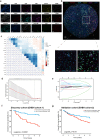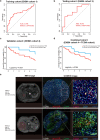A Noninvasive Approach to Evaluate Tumor Immune Microenvironment and Predict Outcomes in Hepatocellular Carcinoma
- PMID: 38223688
- PMCID: PMC10781918
- DOI: 10.1007/s43657-023-00136-8
A Noninvasive Approach to Evaluate Tumor Immune Microenvironment and Predict Outcomes in Hepatocellular Carcinoma
Abstract
It is widely recognized that tumor immune microenvironment (TIME) plays a crucial role in tumor progression, metastasis, and therapeutic response. Despite several noninvasive strategies have emerged for cancer diagnosis and prognosis, there are still lack of effective radiomic-based model to evaluate TIME status, let alone predict clinical outcome and immune checkpoint inhibitor (ICIs) response for hepatocellular carcinoma (HCC). In this study, we developed a radiomic model to evaluate TIME status within the tumor and predict prognosis and immunotherapy response. A total of 301 patients who underwent magnetic resonance imaging (MRI) examinations were enrolled in our study. The intra-tumoral expression of 17 immune-related molecules were evaluated using co-detection by indexing (CODEX) technology, and we construct Immunoscore (IS) with the least absolute shrinkage and selection operator (LASSO) algorithm and Cox regression method to evaluate TIME. Of 6115 features extracted from MRI, five core features were filtered out, and the Radiomic Immunoscore (RIS) showed high accuracy in predicting TIME status in testing cohort (area under the curve = 0.753). More importantly, RIS model showed the capability of predicting therapeutic response to anti-programmed cell death 1 (PD-1) immunotherapy in an independent cohort with advanced HCC patients (area under the curve = 0.731). In comparison with previously radiomic-based models, our integrated RIS model exhibits not only higher accuracy in predicting prognosis but also the potential guiding significance to HCC immunotherapy.
Supplementary information: The online version contains supplementary material available at 10.1007/s43657-023-00136-8.
Keywords: Hepatocellular carcinoma; Immunotherapy response; Prognosis; Radiomic; Tumor immune microenvironment.
© The Author(s) 2023.
Conflict of interest statement
Conflict of InterestThe authors declare no potential conflict of interest.
Figures





References
-
- Abdul Sater H, Marte JL, Donahue RN, Walter-Rodriguez B, Heery CR, Steinberg SM, Cordes LM, Chun G, Karzai F, Bilusic M, Harmon SA, Turkbey IB, Choyke PL, Schlom J, Dahut WL, Madan RA, Pinto PA, Gulley JL. Neoadjuvant PROSTVAC prior to radical prostatectomy enhances T-cell infiltration into the tumor immune microenvironment in men with prostate cancer. J Immunother Cancer. 2020;8(1):e000655. doi: 10.1136/jitc-2020-000655. - DOI - PMC - PubMed
-
- Aerts HJWL, Velazquez ER, Leijenaar RTH, Parmar C, Grossmann P, Cavalho S, Bussink J, Monshouwer R, Haibe-Kains B, Rietveld D, Hoebers F, Rietbergen MM, Leemans CR, Dekker A, Quackenbush J, Gillies RJ, Lambin P. Decoding tumour phenotype by noninvasive imaging using a quantitative radiomics approach. Nat Commun. 2014;5:4006. doi: 10.1038/ncomms5006. - DOI - PMC - PubMed
-
- Binnewies M, Roberts EW, Kersten K, Chan V, Fearon DF, Merad M, Coussens LM, Gabrilovich DI, Ostrand-Rosenberg S, Hedrick CC, Vonderheide RH, Pittet MJ, Jain RK, Zou W, Howcroft TK, Woodhouse EC, Weinberg RA, Krummel MF. Understanding the tumor immune microenvironment (TIME) for effective therapy. Nat Med. 2018;24(5):541–550. doi: 10.1038/s41591-018-0014-x. - DOI - PMC - PubMed
-
- Blazic IM, Lilic GB, Gajic MM. Quantitative assessment of rectal cancer response to neoadjuvant combined chemotherapy and radiation therapy: comparison of three methods of positioning region of interest for ADC measurements at diffusion-weighted MR imaging. Radiology. 2017;282(2):615. doi: 10.1148/radiol.2017164040. - DOI - PubMed
LinkOut - more resources
Full Text Sources
